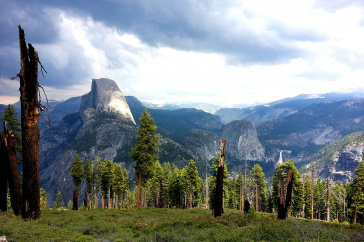The University of New Hampshire inspires innovation and transforms lives in our state, nation and world. More than 16,000 students from all 50 states and 71 countries engage with an award-winning faculty in top-ranked programs in business, engineering, law, health and human services, liberal arts and the sciences across more than 200 programs of study. A Carnegie Classification R1 institution, UNH partners with NASA, NOAA, NSF and NIH, and received $260 million in competitive external funding in FY21 to further explore and define the frontiers of land, sea and space.
UNH Research Finds Wildfires Alter Stream Chemistry for Years

Half Dome at Yosemite after a wildfire.
DURHAM, N.H.—Wildfires alter the chemistry of streams for years, causing significantly lower concentrations of dissolved organic matter that provide a vital energy source to organisms living in streams and rivers, according to new research from the New Hampshire Agricultural Experiment Station at the University of New Hampshire.
Researchers examined the effects of wildfire on stream chemistry and water quality in Yosemite National Park, Calif. They collected water samples from 12 streams that varied in wildfire history and watershed characteristics. Samples were analyzed used a high-resolution chemical analysis to examine how the concentration and composition of dissolved organic matter changes due to wildfire.
“We found that the response of stream chemistry to wildfire in Yosemite can persist for years, varying with both the severity of the last wildfire and site-level characteristics,” said Adam Wymore, research assistant professor of natural resources and the environment. “For example, we found that in streams draining watersheds that experienced high severity fires had significantly lower concentrations of dissolved organic matter.”
Wymore conducted the research with William McDowell, UNH professor of natural resources and the environment; Fernanda Santos and Asmeret Berhe with the University of California Merced; Mažeika Sullivan and Breeanne Jackson with Ohio State University. The research results are presented in the journal Fire Ecology.
Changes in stream chemistry have important implications for the productivity of aquatic ecosystems in fire-prone landscapes. Wildfire frequency and severity is increasing in many regions of the world. In 2018, California experienced its most deadly and destructive wildfire season on record. According to the California Department of Forestry and Fire Protection, the November fire in Butte County burned 153,336 acres, destroyed 18,804 structures, and killed 85 people.
Wildfire frequency and severity is increasing as the result of climate change, shifting precipitation regimes, and more frequent and severe droughts but the effects on stream ecosystems are not well understood, according to Wymore. Most previous studies have examined the effects of wildfire before and after the fire, and only within a single watershed. This research accounts for many factors, including fire severity, time since burn, and watershed characteristics.
The research is particularly important to the Northeast and New Hampshire, which is predicted to experience more frequent dry summers under a shifting climate. “Our study sites in California provide us with an initial predictive framework to understand the potential consequences of wildfire throughout northern New England. This is, in part, due to similar lithology—granite—between the two study sites, which plays an important role in determining the availability of solutes for export to streams and rivers.” Wymore said.
Overall, researchers are interested in understanding how the structure (e.g. vegetation, physical properties, and lithology) of watersheds interacts with both climate and disturbance to affect material (e.g. solutes and sediment) export to stream and rivers. In addition to understanding these fundamental principles regarding watershed and ecosystem function, these complex interactions determine water quality and the health and integrity of downstream receiving waters.
For example, researchers found that the direction that a watershed faces (east, west, north or south) and the structure of specific streams (pools, riffles, runs, and steps) affected results. “This is an excellent example of how a disturbance like wildfire can affect watersheds differently depending on their site-level characteristics and why considering multiple influencing factors is critical to building a holistic understanding of how watersheds respond to disturbance,” Wymore said.
This material is based upon work supported by the NH Agricultural Experiment Station, through joint funding of the National Institute of Food and Agriculture, U.S. Department of Agriculture, under award number 1006760, and the state of New Hampshire. This research also was funded by the National Science Foundation Division of Environmental Biology under award number 1401480 and Bureau of Land Management under award number 14–3–01-37.
Founded in 1887, the NH Agricultural Experiment Station at the UNH College of Life Sciences and Agriculture is UNH’s original research center and an elemental component of New Hampshire's land-grant university heritage and mission.
EDITORS AND REPORTERS: Adam Wymore can be reached at (603) 862-0684 or adam.wymore@unh.edu.
PHOTOS AVAILABLE FOR DOWNLOAD
https://colsa.unh.edu/nhaes/sites/default/files/media/images/cawildfires.jpg
The 2018 Camp Fire in Northern California, from space. Credit: NASA.
https://colsa.unh.edu/nhaes/sites/default/files/media/images/yosemite_fire_halfdome.jpg
Half Dome at Yosemite after a wildfire.
https://colsa.unh.edu/nhaes/sites/default/files/media/images/middletuolumne.jpg
Tuolumne River in Yosemite after a wildfire.
-
Media Contact
Lori Tyler Gula, PhD | NH Agricultural Experiment Station | lori.gula@unh.edu | 603-862-1452
Latest News
-
November 26, 2025
-
November 6, 2025
-
November 5, 2025
-
October 24, 2025
-
October 8, 2025














































